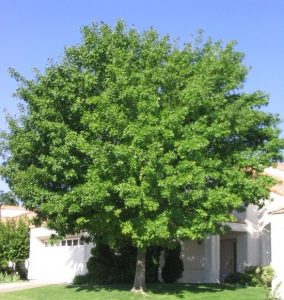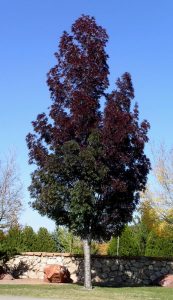by Ken Lain, the mountain gardener

Raywood Ash is a bright source of autumn color and super drought hardy. A good street tree that, with age, provides considerable shade. Plant as a single specimen, in a grove for more widespread shade or seasonal shading on hotter south and west exposures.
The bold round-headed form is perfect to cast summer shade. Dark green foliage turns attractive wine red in fall. Resistant to the Ash blight. Deciduous.
Botanical name: Fraxinus oxycarpa
Common Name: Raywood Ash, Claret Ash
Watering Needs: Once established, it needs only occasional watering.
Plant type: Shade Tree/ Deciduous
Growth habit: Rounded
Growth rate: Fast
Light Needs: 6+ hours Full sun
Water Needs: Once established, needs only occasional watering.
USDA Zone: 6 – 9
Average size: Vigorous grower to 40-50′ ft. tall and almost as wide.
Special features: Fall Color, Waterwise
Foliage color: Dark Green/ Fall is wine red

Light
This is an adaptable plant that does well in full sun to part shade, but a shadier location is sometimes preferred to keep its growth checked.
1.Dig hole 2-3 times the width of the container but the same depth.
2. Score the root ball sides and bottom with a utility knife or pruners and place in the planting hole.
3. Blend Watters Premium Mulch into the native soil at 1 part mulch with two parts soil dug from the hole and pack firmly around the roots.
4. Sprinkle 7-4-4 All Purpose Plant Food around the planting area.
5. Prevent ‘Transplant Shock’ by adding Watters “Root & Grow” to your water at 2-week cycles for the first 2 months.
6. Use remaining Watters Mulch inside the tree well as a top dressing. This will keep weeds down, insulate roots from heat and cold, and keep the roots moist.
How to Water
Always water your newly planted trees thoroughly after transplanting. The roots require plenty of moisture to recover from the stress of the transplant. Failing to water your pampas grass could stunt its growth.
Ensure that you keep the soil uniformly moist. Push your finger an inch into the soil. If it feels damp, then your tree is fine. However, if it’s dry, it means that the roots aren’t getting the moisture they need.
How to Feed for Shady Raywood Ash
During the first year after planting, fertilize Honeysuckle in the early spring, summer, and fall with 7-4-4 All Purpose Plant Food. t can take up to 3-years for a smaller tree to establish itself and provide proper shade.
Design Ideas: Raywood has superior fall color and is very drought resistant. A good street tree that provides fast, dense shade. Plant as a single specimen, in a grove for more widespread shade or seasonal shading on hotter south and west exposures.
Companion Plants: Combine this Ash with other reliable drought-resistant trees such as the attractive Chinese Pistachio, Sweetgum, Russian Sage, Honeysuckle, and Pampas Grass.

